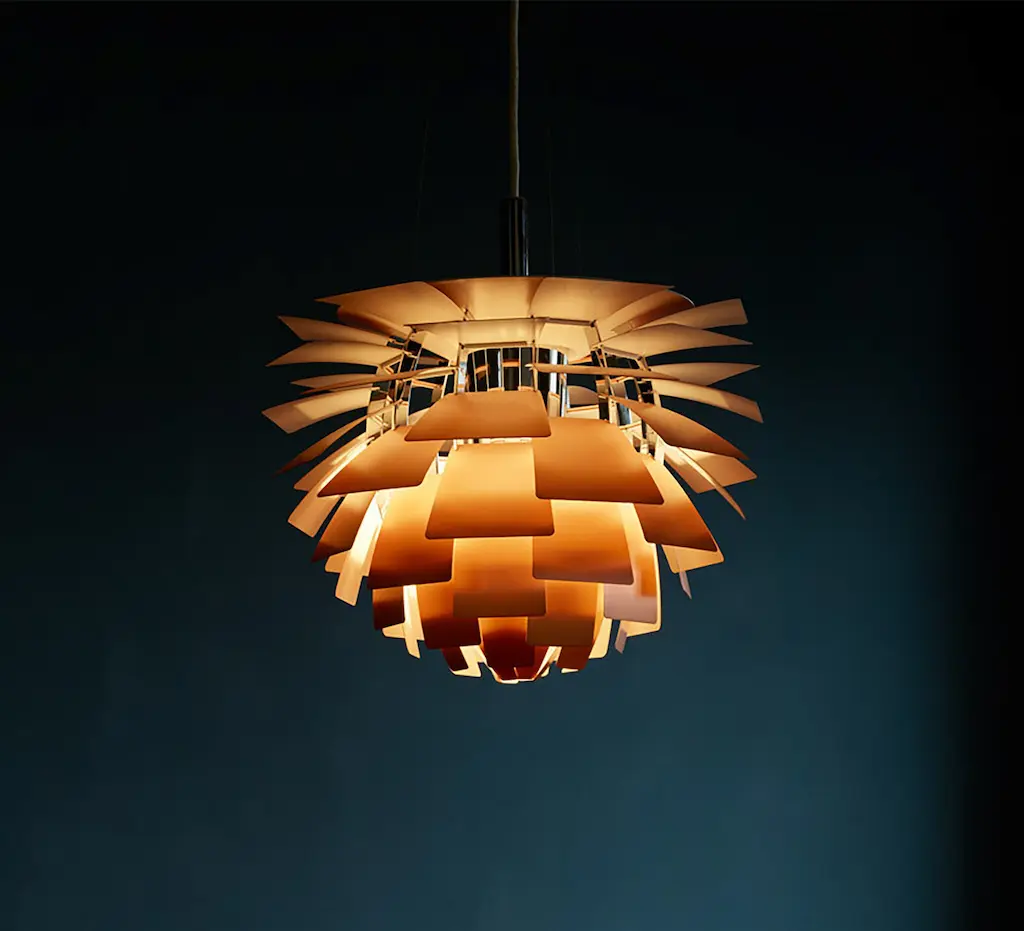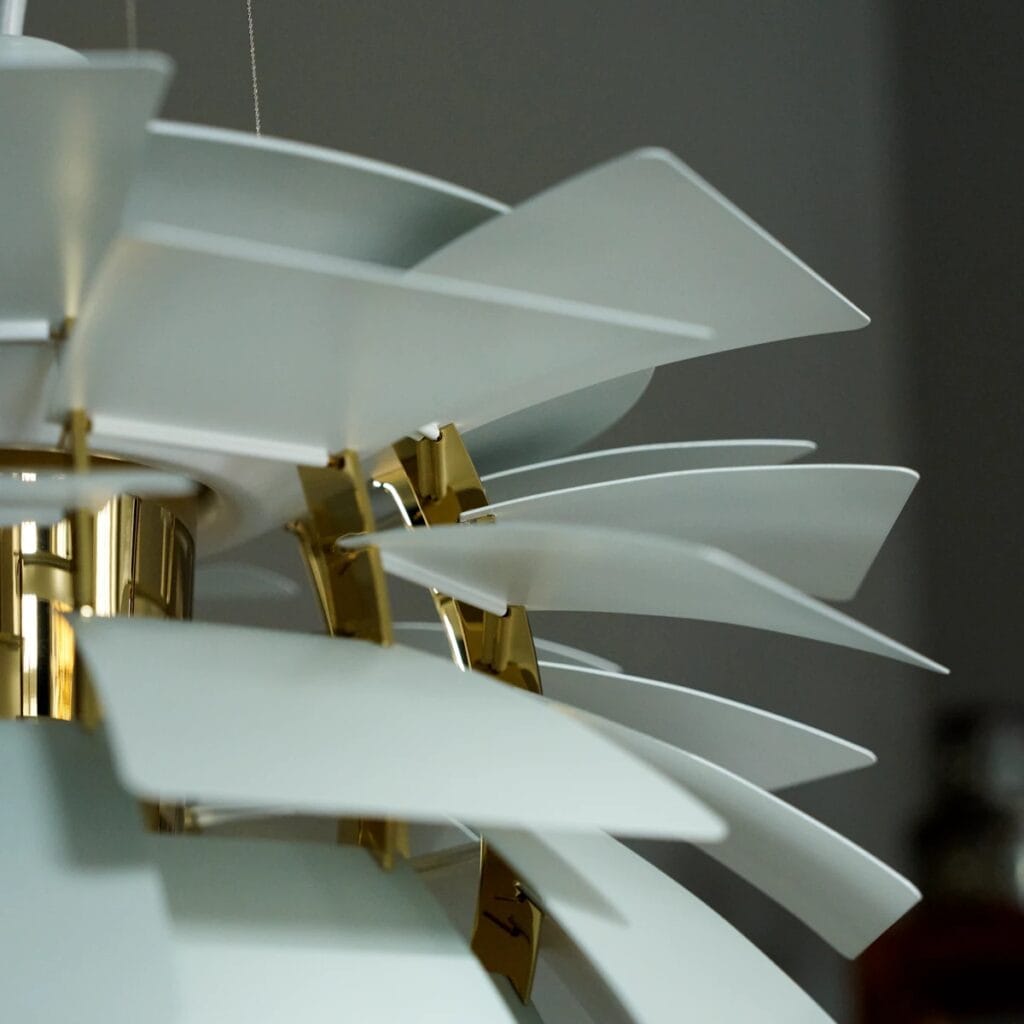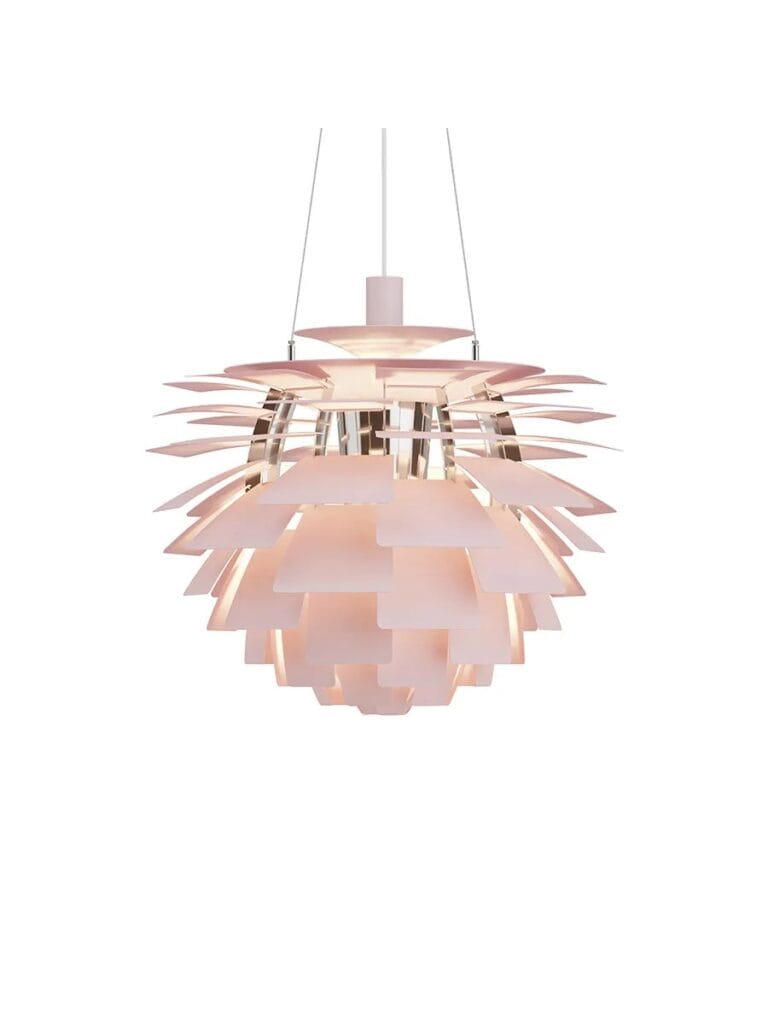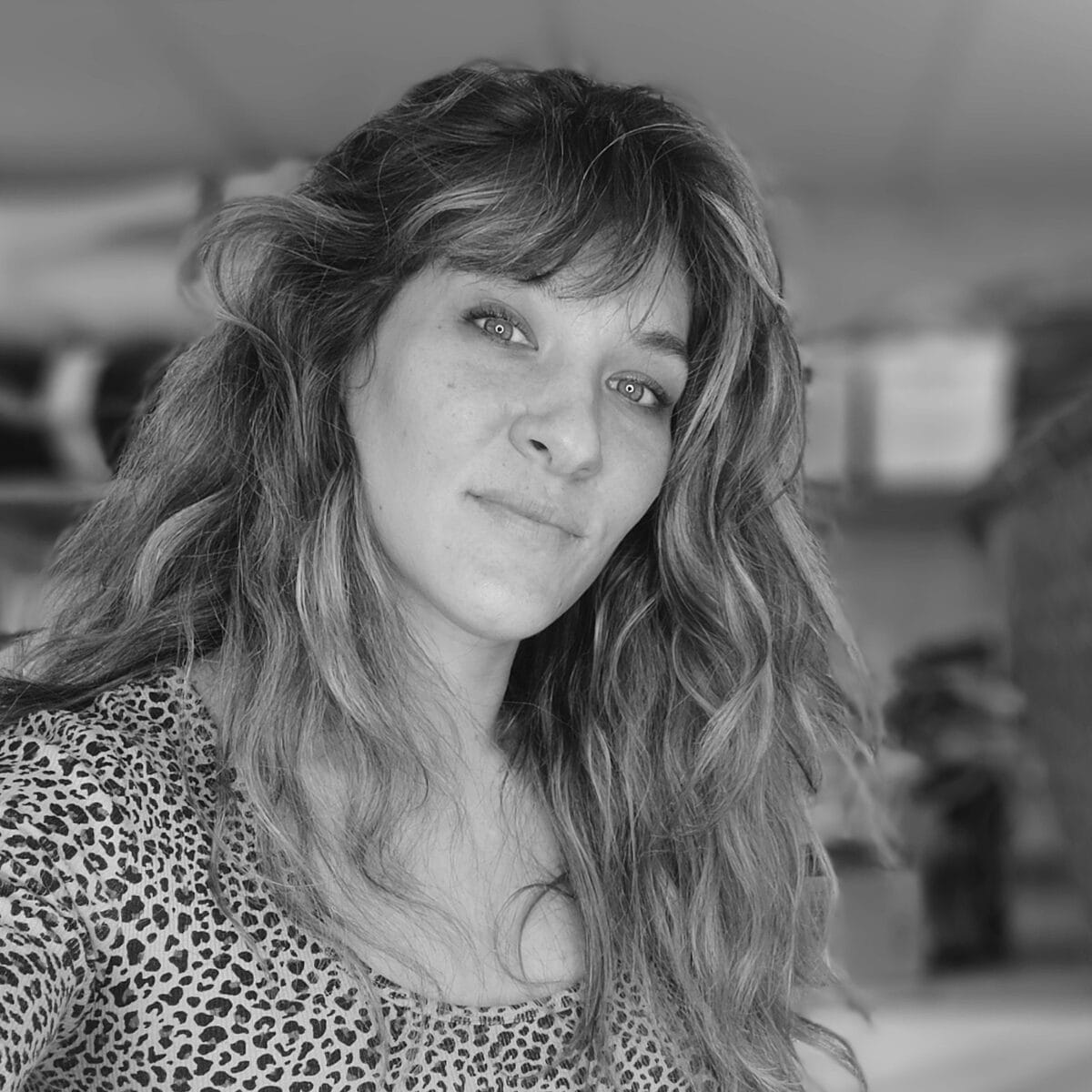In 1958, Danish designer Poul Henningsen created what would become one of the most iconic light fixtures of the 20th century: the Artichoke lamp. This pendant, composed of 72 precisely arranged copper leaves, transcends its utilitarian function to become a sculptural work of art. More than a simple lamp, the Artichoke embodies the marriage of form and function that characterizes Scandinavian design at its peak, where scientific rigor meets organic poetry.
Poul Henningsen: The Architect of Light
Poul Henningsen (1894-1967), known simply as “PH”, was not merely a lighting designer but a true architect of light. Trained as an architect at the Technical College in Copenhagen, though he never completed his studies, Henningsen devoted his career to solving what he considered one of the fundamental problems of modern life: the quality of artificial light.
His obsession began in the 1920s with a simple observation: electric bulbs produced harsh, unpleasant light creating glare and sharp shadows. Unlike the soft glow of candles, bare bulbs assaulted the eye. Henningsen dedicated himself to taming electric light, creating lighting fixtures that would diffuse and reflect illumination to make it comfortable and beautiful.
The PH System: Scientific Foundation
Before the Artichoke, Henningsen developed his famous PH lamp series from 1925 onwards, based on rigorous mathematical and optical principles. His system employed multiple shades arranged according to precise geometric relationships to ensure no direct glare, uniform light distribution, warm color temperature, and aesthetic harmony. These lamps established his international reputation and laid the theoretical foundations for his masterpiece.
The Anti-Glare Philosophy
Henningsen’s work represented a reaction against what he considered the tyranny of the naked bulb in modern interiors. He criticized architects who, in pursuit of minimalist aesthetics, directly exposed light sources. His philosophy maintained that good lighting should be invisible – not the fixture itself, but the light source it contains. The eye should never be assaulted by direct rays from a bulb.
The Artichoke represents the apotheosis of this philosophy: from any angle, viewers never see the bulb directly. Yet the fixture radiates abundant, warm illumination in all directions, creating an almost magical quality.

Birth of a Masterpiece
The Langelinie Pavilion Commission
The Artichoke lamp, known in Danish as “Koglen” (the pinecone), was created in 1958 for the Langelinie Pavilion restaurant in Copenhagen. This modernist building, designed by architects Eva and Nils Koppel, required lighting that was both functional and spectacular. Henningsen rose to this challenge by creating a chandelier that completely concealed its light source while diffusing a warm, radiant presence. The commission allowed him to work without budgetary constraints, pursuing technical perfection and exquisite craftsmanship.
Design and Construction: Precise Anatomy
The Artichoke’s genius lies in its deceptively simple appearance masking extraordinary complexity. The lamp consists of 72 precisely shaped leaves arranged in 12 circular rows, graduated in size (larger at the bottom, smaller toward the top), positioned with geometric precision. Each leaf is angled to reflect light while concealing the bulb. A hidden central steel frame supports the assembly, while a weighted base ensures stability.
Each copper leaf is individually shaped and positioned at a calculated angle. The leaves actively redirect and diffuse light, bouncing it multiple times between their curved surfaces before it emerges as a soft glow. This creates the signature effect: an apparently sourceless illumination that seems to emanate from the fixture itself. The original version measured 60 cm in diameter, though Louis Poulsen has produced versions from 48 cm to 84 cm.

The Choice of Copper: Material Poetry
The choice of copper was deliberate and multidimensional. Its optical properties naturally enhance the color temperature of light, creating a flattering golden glow that makes skin tones healthy and food appetizing. Copper develops a natural patina over time, acquiring character and depth – a transformation Henningsen embraced. Polished copper offers excellent reflection while diffusing harshness, essential to the multi-bounce lighting strategy. Its malleability allowed forming complex shapes through traditional metalworking techniques, connecting modern design to artisanal heritage.
Organic Geometry
The name “Artichoke” (coined by observers, Henningsen preferred “Koglen”) captures the botanical quality of the fixture. Like its vegetable namesake, the lamp’s leaves spiral outward from a central core in an arrangement that is both mathematical and organic. This duality reflects principles of Scandinavian design: the conviction that nature provides optimal solutions to functional problems. The design demonstrates that geometry need not seem cold – when derived from natural principles, mathematical precision can achieve organic warmth.
The Louis Poulsen Partnership and Artisanal Excellence
A Demanding Process
Producing an Artichoke lamp remains a labor-intensive process. Each fixture is hand-assembled at the Louis Poulsen factory in Denmark, with artisans responsible for cutting and shaping each leaf, hand-finishing surfaces, individually positioning the 72 leaves, adjusting angles, and quality control. This artisanal approach means a single fixture can take days to complete, explaining the substantial price (€8,000 to €15,000), positioning it as an investment representing both functional lighting and quality design.
Material Variations
While the polished copper version remains most iconic, Louis Poulsen offers finishes in copper (polished, brushed, oxidized), steel (stainless, brushed), and painted white versions. Each material choice affects aesthetic appearance and quality of emitted light, demonstrating Henningsen’s principle that lighting design fundamentally concerns material properties and their interaction with light.
Technical Innovation and Lighting Science
Multi-Reflection System
The lighting system represents sophisticated optical engineering. Light follows this path: bulb emission, primary reflection on interior leaf surfaces, secondary bounces between multiple surfaces, diffusion through multiple reflections, then emission of transformed light. This multi-bounce strategy eliminates hard shadows, warms color temperature, reduces contrast ratios, and maximizes efficiency.

Excellence in Color Rendering
Henningsen understood that light quality affects perception of colors, textures, and people. Copper leaves act as color filters, enhancing warm wavelengths while slightly suppressing cool ones. This creates exceptionally flattering light rendering skin tones healthy, food appetizing, wood and natural materials luminous, and atmospheres intimate. Modern science has validated Henningsen’s intuitive understanding: color temperature significantly affects mood. The Artichoke’s output of approximately 2700-3000K sits in the optimal range for residential and hospitality environments.
Contemporary LED Adaptation
Maintaining the Artichoke’s relevance in the LED era presented challenges. Louis Poulsen successfully adapted by using high-CRI LEDs (>90) reproducing warm incandescent glow, integrating discreet thermal management systems, ensuring smooth dimming curves, and offering 25,000 to 50,000-hour lifespans. This technological transition demonstrates the robustness of fundamental design – its optical principles remain valid regardless of light source technology.
Energy Performance
The LED transition transformed the energy profile: where an incandescent version consumed 150-200 watts, current LED versions require only 25-40 watts. LEDs generate less heat, reducing air conditioning loads. With 25,000 to 50,000 hours of use, an LED Artichoke can function 15 to 30 years with normal daily usage. Longevity combined with energy efficiency positions the Artichoke as an ecologically responsible choice.
Cultural Impact and Iconic Status
Ambassador of Scandinavian Design
The Artichoke lamp became one of the most recognizable symbols of Scandinavian design’s golden age (1950s-1960s), alongside works by Arne Jacobsen, Hans Wegner, and Finn Juhl. It embodied core values: functionalism (every element serves a purpose), craftsmanship (quality materials and construction), timelessness (avoiding trendy styling), democratic ideals (good design improves daily life), and natural materials. Though expensive, the Artichoke represented the aspiration to create objects of lasting value – an early articulation of sustainable design principles.
Interior Design Icon
The Artichoke quickly transcended its restaurant context to become a coveted residential fixture. Its presence in interiors signaled design sophistication, investment in quality, Scandinavian aesthetics, and architectural awareness. Design magazines featured it in countless interiors throughout the 1960s-1970s, establishing it as a status symbol. It’s now instantly recognized by design enthusiasts worldwide.

Museum Collections
The design’s importance has been recognized through inclusion in major museum collections: Museum of Modern Art (MoMA) New York, Victoria and Albert Museum London, Designmuseum Danmark Copenhagen, and Vitra Design Museum Germany. These institutional validations confirmed the Artichoke’s status as a significant cultural artifact – a benchmark of 20th-century design achievement worthy of preservation and study.
Media Presence and Contemporary Influence
Over decades, the lamp transcended its design object status to become a recognizable cultural symbol. It regularly appears in films and series evoking Scandinavian sophistication, is a recurring subject in design publications, and has become a favored Instagram subject thanks to its sculptural, photogenic form.
The legacy also measures through influence on subsequent generations: many contemporary designers have adopted the fundamental principle of source concealment, the idea of systematic lighting approach, and the ability to appear simultaneously organic and technological.
The Artichoke in Contemporary Contexts
Size Range
Louis Poulsen produces the Artichoke in multiple dimensions: PH Artichoke 48 (48 cm, for intimate spaces), PH Artichoke 60 (60 cm, the original 1958 size), PH Artichoke 72 (72 cm, for double-height spaces), and PH Artichoke 84 (84 cm, for monumental spaces). This range testifies to the robustness of design principles: geometric relationships function at all scales.
Residential and Commercial Applications
Though originally designed for public spaces, the Artichoke found enthusiastic residential adoption in dining rooms, living spaces, bedrooms, entrance halls, and home offices. It remains popular in commercial contexts where lighting quality directly affects business outcomes: restaurants (creating essential warm atmosphere), hotels, corporate offices, and high-end retail spaces. In these applications, cost becomes justifiable through marketing value and longevity.
Smart Home Integration
21st-century adaptation also concerns integration into modern smart home ecosystems: intelligent dimming compatible with DALI, DMX, or wireless protocols, ambiance control with systems like Philips Hue, and scene programming for commercial contexts. This modernization occurs invisibly, preserving aesthetic integrity.
Collectability and Market
Market Value
Original 1958 lamps have become highly collectable: early production models (1958-1970): €15,000 to €30,000+, mid-period examples (1980-1990): €8,000 to €15,000, new contemporary production: €7,000 to €12,000. This solid market reflects historical design importance, artisanal quality, material value, enduring aesthetics, and limited production. For collectors, the Artichoke represents investment-quality design.
Authentication and Replicas
Iconic status has spawned numerous unauthorized copies (€500 to €2,000). For authentic purchase: buy from authorized Louis Poulsen dealers, verify documentation (certificate of authenticity), confirm Louis Poulsen and PH markings, be vigilant about pricing (authentic costs €7,000 to €15,000). Purists argue replicas fundamentally misunderstand the Artichoke: its value lies in precision engineering creating its characteristic light quality.
Installation Advice
Size selection depends on ceiling height (48 cm for 2.40-2.70 m, 60-72 cm for 3 m+, 84 cm for 4.50 m+), room dimensions (diameter in cm should approximately correspond to sum of room dimensions in meters), space function, and table placement (recommended distance: 65-75 cm). For more guidance on selecting exceptional lighting, consult our complete guide.
Influence and Lasting Legacy
Impact on Lighting Design
Henningsen’s work fundamentally influenced post-war lighting design: pendant as sculpture, optical sophistication, material honesty, and systemic thinking. Designers from Ingo Maurer to Tom Dixon acknowledge his influence, particularly his demonstration that lighting design is a distinct discipline requiring expertise in optics, materials, and human perception.
Contemporary Relevance
More than 65 years after creation, the lamp remains continually relevant through timeless proportions based on geometric and natural principles, functional excellence, material authenticity, artisanal value, and sustainable longevity. It successfully transitioned from mid-century modern icon to simply modern icon – achieving something universal and enduring.
Special Editions and Future Evolution
Louis Poulsen has produced anniversary editions, experimental finishes (black copper, brushed brass), and miniature versions. The future might see new materials (advanced composites, innovative alloys), advanced technological integration (sensors, automatic adjustment), customization options, and sustainability programs (repairability, takeback and reconditioning, material traceability).

A Luminous Legacy
The Artichoke lamp represents far more than an exceptional light fixture. It embodies a design philosophy where beauty emerges from intelligent problem-solving, where technology serves humanity, where lasting quality prevails over ephemeral novelty.
In a world saturated with mass-produced, rapidly obsolete objects, the Artichoke reminds us another path exists: that of patient creation of objects meant to last, designed with scientific rigor and artistic sensitivity, crafted with artisanal care and noble materials.
Sixty-five years after creation, the lamp continues illuminating interiors worldwide. It lights not only our physical spaces but also our understanding of what design can be at its best: functional and beautiful, technical and poetic, innovative and timeless.
The Artichoke teaches that the most enduring objects are those justly designed – where every element responds to functional necessity while contributing to overall aesthetic harmony. In this era when we must rethink our relationship with objects, Poul Henningsen’s masterpiece offers an inspiring model of organic design.
The Artichoke lamp thus remains a beacon of 20th-century design, illuminating not only the spaces it inhabits but also the path toward more thoughtful, more sustainable, more human design – a luminous legacy that continues to shine.

Digital entrepreneur and craft artisan, I use my unconventional background to share my vision of luxury design and interior decoration — one enriched by craftsmanship, history, and contemporary creation. Since 2012, I have been working daily in my workshop on the shores of Lake Annecy, creating bespoke interiors for discerning decorators and private clients.
